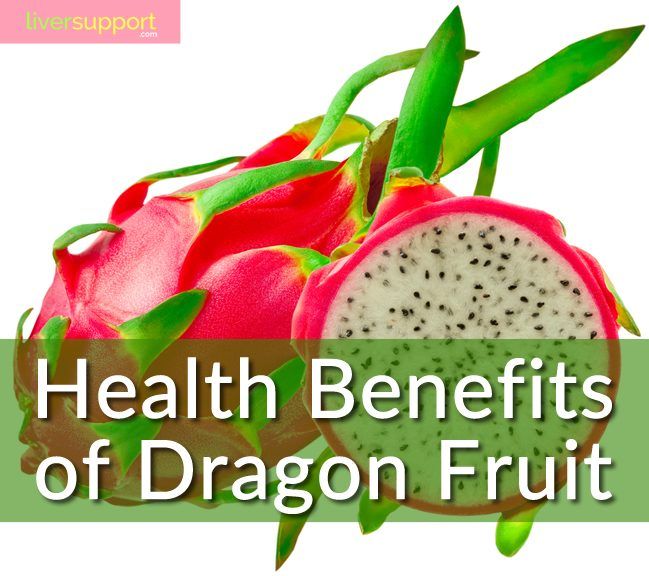
Previous
Liver Cysts: Symptoms, Causes and Treatment

Next
6 Tea Ingredients to Help Detox Your Liver and Aid Digestion
Dragon Fruit Shields Against a Fatty Liver
Despite its whimsical, fun appearance, dragon fruit is serious when it comes to your liver’s health.
It’s hard not to be curious about the dragon fruit, a hot pink, exotic tropical fruit that is native to Mexico and Central America. Dragon fruit is making its way into many of America’s supermarkets, yet few know what to do with it, how it tastes or if it is good for you.
Not only is this brightly colored, spike-studded fruit tasty, but it also positively impacts insulin resistance, metabolic syndrome and a fatty liver.
Growing on the Hylocereus cactus, dragon fruit is also called pitaya, pitahaya and strawberry pear. The flowers on the fruit only open at night, and its appearance vaguely resembles a dragon – boasting a bright pink exterior with green spikes. The most common dragon fruit variety contains white pulp with small, black, edible seeds.
Eating Dragon Fruit
Despite its otherworldly façade, most people describe dragon fruit’s taste as a familiar cross between a kiwi and a pear. The mildly sweet and slightly sour pulp is crunchy and can be accessed by slicing lengthwise and scooping out the flesh or quartering the fruit and peeling back the leathery skin. The white flesh with black seeds is the edible part, the pink leathery exterior is bitter.
Although its possibilities are limitless, the most common ways to consume dragon fruit are:
- eaten straight out of its skin
- chopped up and topped with yogurt or ice cream
- spread over a salad
- frozen in fruit juice or nectar to make a popsicle
- blended in a smoothie
Besides its versatility in the kitchen, dragon fruit also harbors many health benefits.
Health Benefits of Dragon Fruit
Good for a variety of health conditions, this hot pink fruit contains some valuable nutrients. A great source of Vitamin C (one serving contains 34 percent of the recommended daily intake), dragon fruit is also rich in iron, low in calories and high in fiber. In addition, dragon fruit contains several types of antioxidants that protect cells from damage – which reduces chronic disease risk and minimizes aging.
Three different types of antioxidants that are found in dragon fruit pulp are:
- Betalains – These antioxidants prevent low-density-lipoprotein cholesterol from being oxidized.
- Hydroxycinnamates – These antioxidants have an anti-cancer effect.
- Flavonoids – These antioxidants help support and maintain neurological and cardiovascular health.
Insulin Resistance and Fatty Liver
Aside from the broad range of health benefits offered by these three groups of antioxidants, dragon fruit has a unique characteristic in that it has been shown to reduce insulin resistance and a fatty liver – which contribute to diabetes, fatty liver disease and metabolic syndrome. Although the studies over the past few years all recruited animal subjects, many believe the researchers’ conclusions are likely to apply to humans as well.
- As published in a 2014 edition of BMC Complementary and Alternative Medicine, researchers evaluated changes in hepatic function in subjects fed a high-carbohydrate, high-fat diet after supplementing with dragon fruit juice. The subjects drinking dragon fruit juice had lower liver enzymes than those not drinking dragon fruit juice, leading the researchers to conclude that this fruit might be useful in fighting off metabolic syndrome.
- As published in a 2015 edition of the Journal of Gastroenterology and Hepatology, researchers investigated the metabolic effects of the betalains extracted from dragon fruit. They found that these dragon fruit antioxidants reduced visceral obesity, minimized fat accumulation in the liver and improved insulin resistance. The researchers concluded there may be a clinical application for dragon fruit’s antioxidants in managing obesity, non-alcoholic fatty liver disease and type 2 diabetes.
- As published in a 2016 edition of the journal PlosOne, researchers evaluated the influence of white dragon fruit juice on obesity-related metabolic disorders (like insulin resistance and hepatic steatosis) in high-fat diet-fed subjects. They found that the dragon fruit helped reduce high-fat, diet-induced insulin resistance, hepatic steatosis and fat accumulation. The researchers concluded that dragon fruit protects from a diet-induced fatty liver and insulin resistance.
Dragon fruit is a relative newcomer to American supermarkets, and does not have decades of human studies to support its specific health benefits. Nonetheless, the information available thus far indicates that dragon fruit would make an ideal sweet treat for anyone interested in preventing insulin resistance and a fatty liver.
Editor’s Note: Clinical LiverSupport provides comprehensive liver care, and can help reduce fat accumulation in your liver.
http://foodfacts.mercola.com/dragon-fruit.html, What is Dragon Fruit Good For?, Retrieved July 17, 2016, Dr. Joseph Mercola, 2016.
http://journals.plos.org/plosone/article?id=10.1371/journal.pone.0149670, White Pitaya (Hylocereus undatus) Juice Attenuates Insulin Resistance and Hepatic Steatosis in Diet-Induced Obese Mice, H. Song, et al, Retrieved July 17, 2016, Plos One, February 2016.
http://www.ncbi.nlm.nih.gov/pubmed/24919841, Effects of red pitaya juice supplementation on cardiovascular and hepatic changes in high-carbohydrate, high-fat diet-induced metabolic syndrome rats, Ramli NS, et al, Retrieved July 17, 2016, BMC Complementary and Alternative Medicine, June 2014.
http://www.ncbi.nlm.nih.gov/pubmed/26699443, Red pitaya betacyanins protects from diet-induced obesity, liver steatosis and insulin resistance in association with modulation of gut microbiota in mice, Song H, et al, Retrieved July 17, 2016, Journal of Gastroenterology and Hepatology, December 2015.
http://www.thedailymeal.com/what-dragon-fruit-and-does-it-have-health-benefits, What is Dragon Fruit and Does it Have Health Benefits?, Franziska Spritzler, RD, CDE, Retrieved July 17, 2016, Spanfeller Media Group, Inc., 2016.







thank you for the article about dragon fruit.. it feels good every time I ate or drink dragon fruit juice
Thank you for this information, that Pitaya also shields against a fatty liver
Dragon Fruit has so many benefits – I love Dragonfruit
https://uploads.disquscdn.com/images/2888559697eada05d70072655d94d826c88dc930bc6a390c4eb78a11d6f78063.jpg